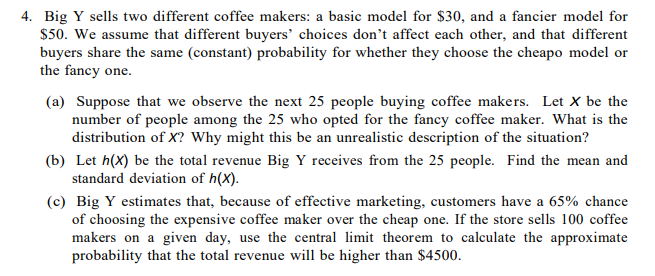4. Big Y sells two different coffee makers: a basic model for $30, and a fancier model for $50. We assume that different buyers' choices don't affect each other, and that different buyers share the same (constant) probability for whether they choose the cheapo model or the fancy one. (a) Suppose that we observe the next 25 people buying coffee makers. Let X be the number of people among the 25 who opted for the fancy coffee maker. What is the distribution of X? Why might this be an unrealistic description of the situation? (b) Let h(X) be the total revenue Big Y receives from the 25 people. Find the mean and standard deviation of h(X). (c) Big Y estimates that, because of effective marketing, customers have a 65% chance of choosing the expensive coffee maker over the cheap one. If the store sells 100 coffee makers on a given day, use the central limit theorem to calculate the approximate probability that the total revenue will be higher than $4500.
4. Big Y sells two different coffee makers: a basic model for $30, and a fancier model for $50. We assume that different buyers' choices don't affect each other, and that different buyers share the same (constant) probability for whether they choose the cheapo model or the fancy one. (a) Suppose that we observe the next 25 people buying coffee makers. Let X be the number of people among the 25 who opted for the fancy coffee maker. What is the distribution of X? Why might this be an unrealistic description of the situation? (b) Let h(X) be the total revenue Big Y receives from the 25 people. Find the mean and standard deviation of h(X). (c) Big Y estimates that, because of effective marketing, customers have a 65% chance of choosing the expensive coffee maker over the cheap one. If the store sells 100 coffee makers on a given day, use the central limit theorem to calculate the approximate probability that the total revenue will be higher than $4500.
Holt Mcdougal Larson Pre-algebra: Student Edition 2012
1st Edition
ISBN:9780547587776
Author:HOLT MCDOUGAL
Publisher:HOLT MCDOUGAL
Chapter11: Data Analysis And Probability
Section11.8: Probabilities Of Disjoint And Overlapping Events
Problem 2C
Related questions
Question
M-4
Please help me with the below question needed with a clear step by step explanation, please
NEEDED ALL PARTS PLEASE

Transcribed Image Text:4. Big Y sells two different coffee makers: a basic model for $30, and a fancier model for
$50. We assume that different buyers' choices don't affect each other, and that different
buyers share the same (constant) probability for whether they choose the cheapo model or
the fancy one.
(a) Suppose that we observe the next 25 people buying coffee makers. Let X be the
number of people among the 25 who opted for the fancy coffee maker. What is the
distribution of X? Why might this be an unrealistic description of the situation?
(b) Let h(X) be the total revenue Big Y receives from the 25 people. Find the mean and
standard deviation of h(X).
(c) Big Y estimates that, because of effective marketing, customers have a 65% chance
of choosing the expensive coffee maker over the cheap one. If the store sells 100 coffee
makers on a given day, use the central limit theorem to calculate the approximate
probability that the total revenue will be higher than $4500.
Expert Solution
This question has been solved!
Explore an expertly crafted, step-by-step solution for a thorough understanding of key concepts.
Step by step
Solved in 2 steps with 2 images

Recommended textbooks for you

Holt Mcdougal Larson Pre-algebra: Student Edition…
Algebra
ISBN:
9780547587776
Author:
HOLT MCDOUGAL
Publisher:
HOLT MCDOUGAL


Holt Mcdougal Larson Pre-algebra: Student Edition…
Algebra
ISBN:
9780547587776
Author:
HOLT MCDOUGAL
Publisher:
HOLT MCDOUGAL
